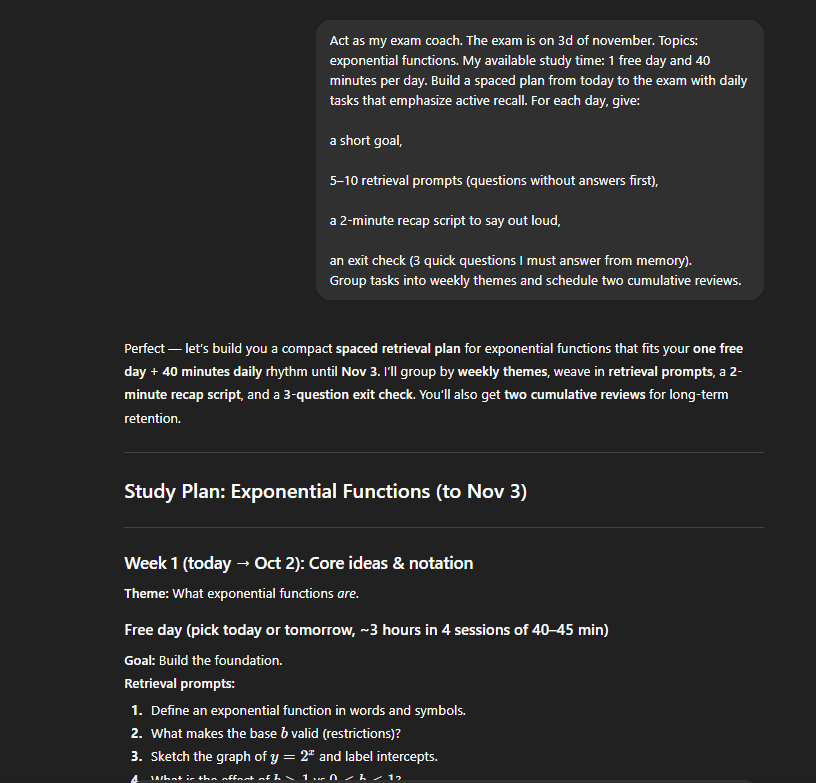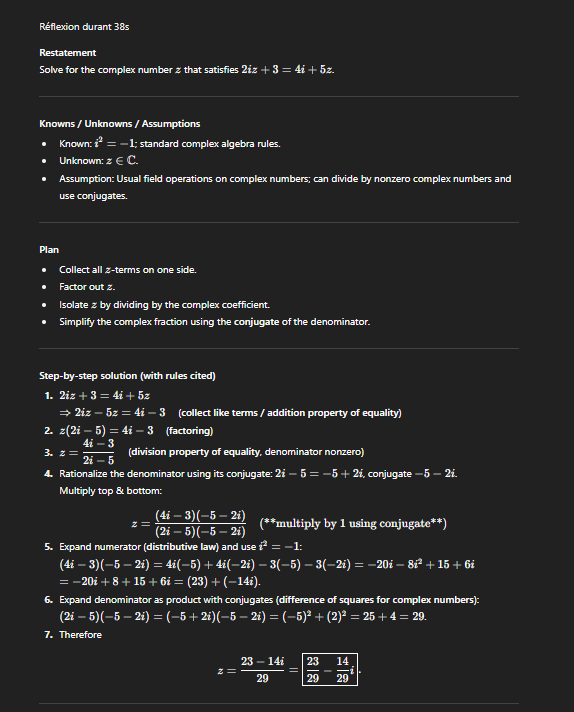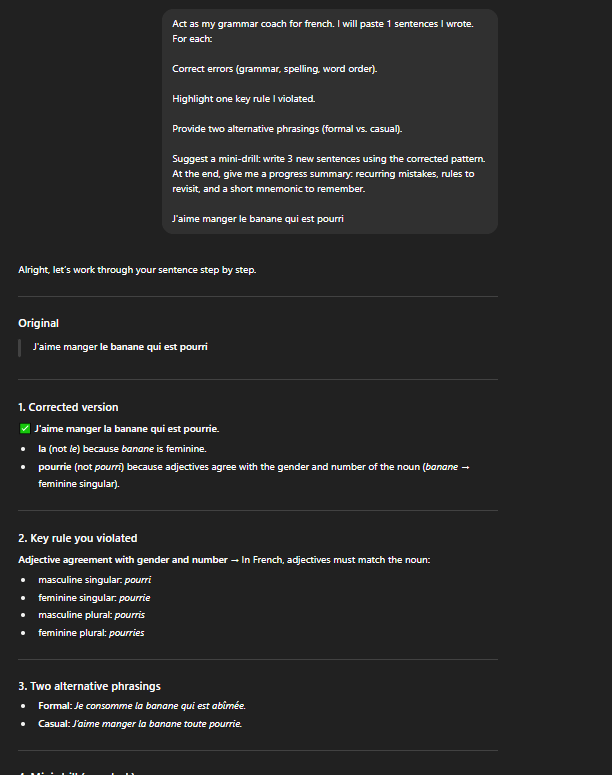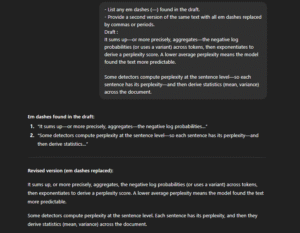You’ve probably asked ChatGPT to “help with studying” or “explain this concept,” only to get walls of text that felt generic, incomplete, or just… boring.
But the problem isn’t necessary the tool -it’s the way you prompt it.
This guide shows you the best prompts for students who want to learn faster, write better, and study with less stress.
Prompts for Understanding & Learning New Concepts

You learn faster when a prompt pushes you to reason, explain, and check yourself. Use these three prompts to make ChatGPT guides you through ideas.
Prompt 1 — Socratic tutor that leads you to the idea
Copy-paste:
“Act as a Socratic tutor for a beginner. I want to learn [concept]. Ask me one question at a time that moves from intuition to formal understanding, wait for my reply, and then give minimal hints before the next question. After 6–8 questions, summarize what I’ve learned, list two misconceptions to watch for, and give a 30-second recap.”
Evidence from education research shows Socratic questioning can build higher-order thinking and is well-received by students when compared to didactic lectures.
Prompt 2 — Self-explain, then get targeted feedback
Copy-paste:
“I will explain [concept] in my own words in 120–150 words, including one example and one analogy. After I paste it, grade my explanation on clarity, accuracy, and depth using a 10-point rubric; highlight what’s missing, rewrite a crisper version, and give two reflection questions I should answer next.”
You’re exploiting the self-explanation effect: when you generate an explanation, you integrate new ideas with what you already know, spot gaps, and remember more later.
Prompt 3 — Analogy
Copy-paste:
“Teach me [concept] using two everyday analogies from [domain I know: music, sports, cooking]. Then contrast the analogies with the formal definition so I don’t over-generalize. List three common misconceptions and how to avoid them. Finish with a 3-minute retrieval drill: 6 short questions (no answers first), then show answers and explain why each wrong choice is wrong.”
Analogies help you anchor abstractions to familiar experiences, and when you follow them with a clear contrast against the formal definition, you keep the benefits of intuition without importing false assumption.
Prompts for Preparing Essays

Use these three prompts to move from messy notes to a clean, source-driven paper without losing your voice.
Prompt 1 — Essay drafting
Copy-paste:
“Act as my argument coach. I’m writing about [topic] for [course/level]. Ask 5 clarifying questions to narrow scope and audience. Then propose 3 thesis options (concise, arguable, specific). For the best thesis, build an argument map:
- 3–4 main claims with one key source to support each,
- likely counterarguments and how to address them,
- evidence gaps I need to research,
- a working title and a one-sentence abstract.”
Prompt 2 — Outline Generator
Copy-paste:
“Act as a literature review assistant. My topic is [topic]. Create a section-by-section outline using the IMRaD or thematic structure (choose the best fit and say why). For each section, list:
- Key questions that section must answer,
- 3–5 claim statements I could make,
- for each claim, the type of source needed (meta-analysis, seminal study, policy report),
- quality checks I should perform (recency, sample size, methodology),
- a mini-synthesis sentence that shows how studies agree, diverge, or leave gaps.
End with a search plan (databases, strings, inclusion/exclusion rules) and a note-taking template (fields for citation, methods, findings, limits).”
Prompt 3 — Paragraph writer
Copy-paste:
“I will write a topic sentence and paste bullet notes plus citation stubs. Turn this into one evidence-rich paragraph that:
- integrates at least two sources with signals (“Smith (2021) finds…”, “However, Lee (2023)…”),
- balances summary, paraphrase, brief quote (≤15 words),
- includes a contrast or limitation,
- ends with a clear takeaway.
Then run two revision passes:
- Clarity pass (shorten, remove hedging, keep my voice),
- Citations pass (format in [APA/MLA/Chicago], add placeholders if details are missing).
Return the final paragraph plus a 1-line note on what evidence would strengthen it.”
Prompts for Studying for Exams / Memorization

You remember more when you practice retrieval, space your reviews, and track your mistakes. Use these three prompts to turn study time into focused, measurable gains.
Prompt 1 — Study plan
Copy-paste:
“Act as my exam coach. The exam is on [date]. Topics: [list]. My available study time: [days per week, minutes per day]. Build a spaced plan from today to the exam with daily tasks that emphasize active recall. For each day, give:
- a short goal,
- 5–10 retrieval prompts (questions without answers first),
- a 2-minute recap script to say out loud,
- an exit check (3 quick questions I must answer from memory).
Group tasks into weekly themes and schedule two cumulative reviews.”
Prompt 2 — Self-test engine
Copy-paste:
“Be my self-test engine for [course]. Generate 12 mixed questions (MCQ, short answer, explain-in-your-own-words). Show questions only first. After I answer, ask me to mark confidence (0–3) for each. Then reveal answers with brief explanations, plus a mistake analysis section that:
- groups errors by concept,
- explains why my answer was wrong,
- gives a fix-it prompt I can practice,
- adds each miss to an error log with a suggested review date.
End with 3 synthesis questions that connect multiple topics.”
Prompt 3 — Interleaved practice
Copy-paste:
“Create a 40-minute interleaved session for [subjects/topics]. Mix problems so no two consecutive tasks cover the same skill. For each task, provide:
- a one-line cue only,
- a time box (1–3 minutes),
- a hint I can request if stuck.
After 30 minutes, switch to teach-back: ask me to explain three core ideas to a beginner in 90 seconds each. Evaluate my explanations on accuracy, clarity, and key terms, then suggest a sharper version I can memorize.”
Prompts for Problem Solving (Math, Science, Coding)

Use these three prompts to turn the model into a problem-solving partner, not a shortcut machine.
Prompt 1 — Step-by-step solver
Copy-paste:
“Act as a methodical tutor. I’ll paste a [math/science/coding] problem.
- Restate the problem in your own words.
- List knowns/unknowns and assumptions.
- Propose a plan (bullets).
- Solve step by step, naming the rule/theorem/command at each step.
- Provide a unit or sanity check (or run a small test case for code).
- Do an error hunt: list two likely mistakes a student might make and how to avoid them.
Return a short decision tree for what to try if my first plan fails.”
Prompt 2 — Problem solving coach
Copy-paste:
“Be my strategy coach for this [math/science/coding] problem.
- Propose three distinct solution methods.
- For each, explain when it works, time/space complexity (if code), pros/cons, and failure modes.
- Pick the best for my constraints ([time limit, tools allowed, accuracy needs]).
- Solve using that method but also write a one-paragraph ‘why this beats the others’ note.
- End with a quick-switch guide: if I hit obstacle X, how to switch to method Y.”
Prompt 3 — Coding tutor
Copy-paste:
“Act as a test-driven tutor. Goal: implement [function/algorithm].
- Draft unit tests first: include happy path, edge cases, and failure cases; show expected outputs.
- Suggest a minimal design (function signature, data structures).
- Provide a clean initial implementation.
- Run a mental test pass: point out which tests pass/fail and why.
- Propose refactors (readability, complexity, memory).
- Add assertions and input validation.
- Explain common pitfalls and how to spot them in logs.”
Prompts for Language Learning (Grammar, Translation, Writing Practice)

You progress faster in a new language when your prompts push you to practice actively, get corrections, and see patterns. Use these three prompts to build grammar confidence, sharpen translation, and develop a natural writing voice.
Prompt 1 — Grammar coach
Copy-paste:
“Act as my grammar coach for [language]. I will paste 4–5 sentences I wrote. For each:
- Correct errors (grammar, spelling, word order).
- Highlight one key rule I violated.
- Provide two alternative phrasings (formal vs. casual).
- Suggest a mini-drill: write 3 new sentences using the corrected pattern.
At the end, give me a progress summary: recurring mistakes, rules to revisit, and a short mnemonic to remember.”
Prompt 2 — Translation partner
Copy-paste:
“Be my translation partner from [language A] to [language B]. I’ll paste a short passage. Please:
- Provide a literal translation first.
- Rewrite with natural flow (as a native would say it).
- Explain cultural or idiomatic choices (why ‘X’ works better than ‘Y’).
- Show false friends or traps in this passage.
- Create a mini-drill: 5 sentences that test me on these pitfalls.
Finish with a two-column table: original → natural version, so I can compare at a glance.”






